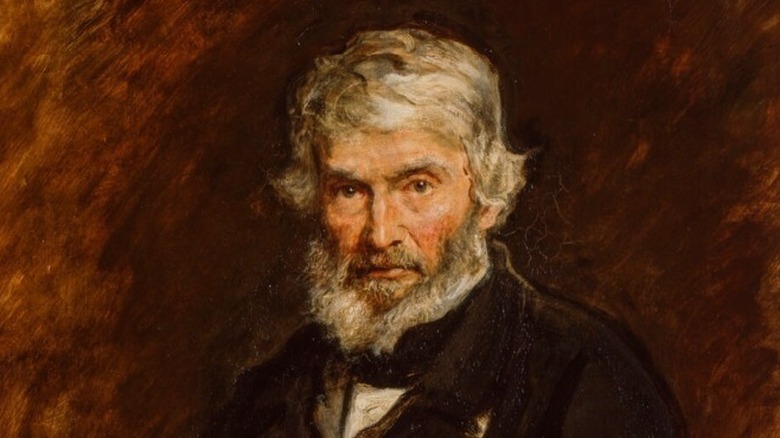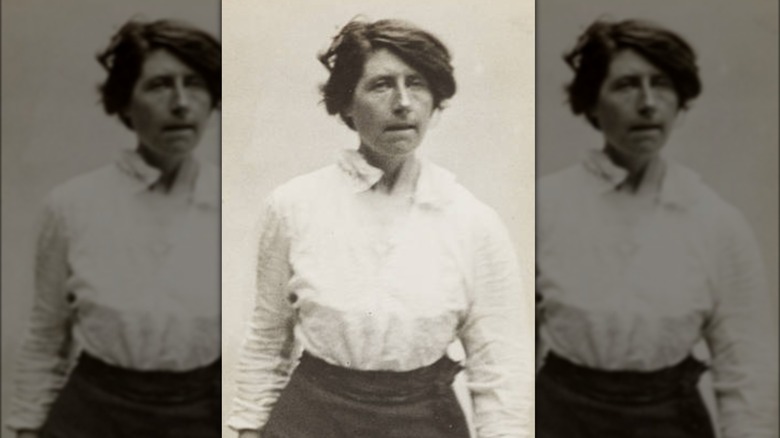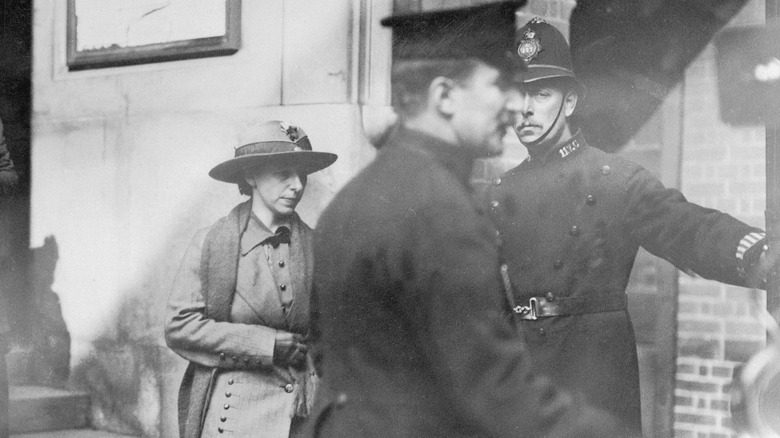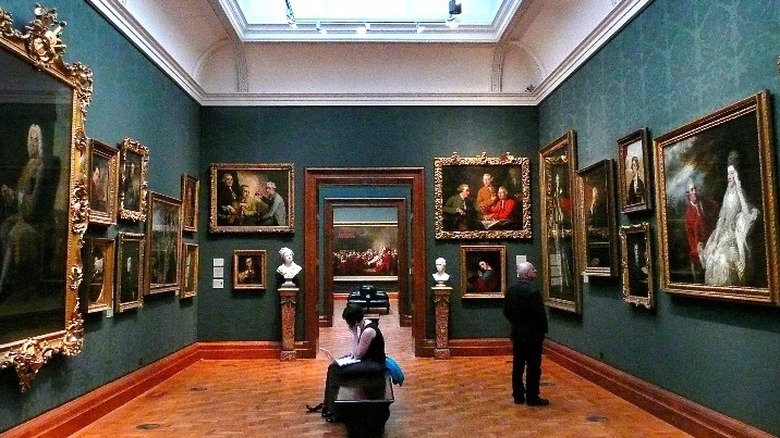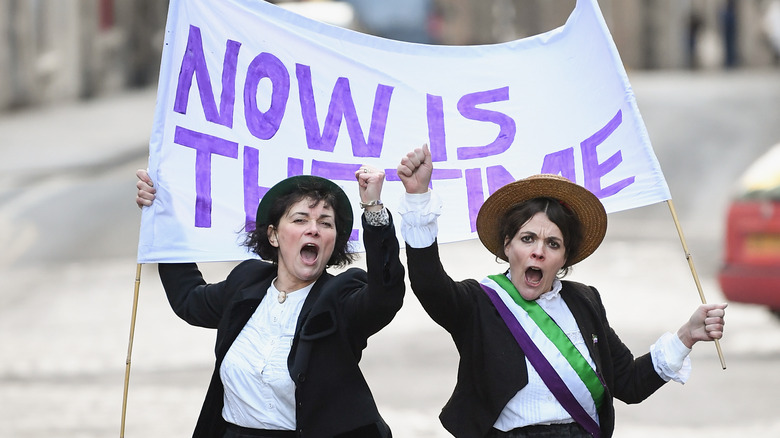The British Suffragette Who Attacked A Portrait With A Hatchet
When two young climate activists tossed a can of tomato soup at Vincent Van Gogh's "Sunflowers" in London's National Gallery on October 14, 2022, the gesture seemed to come out of nowhere (via Just Stop Oil). People wondered why the activists would target a famous work of art instead of something more obviously related to their cause, like a pipeline or an oil CEO's mansion. However, it turns out that art-related protests have a longer history in United Kingdom activism than you might expect. Just ask the suffragettes.
On July 17, 1914, a woman calling herself Anne Hunt walked into London's National Portrait Gallery and slashed a picture of Thomas Carlyle by Sir John Everett Millais with a butcher's cleaver, as the Boston Evening Transcript reported at the time. Unlike the Just Stop Oil protesters, who knew the painting was covered by glass before they approached it with soup, Hunt made an effort to damage the painting itself (via The Guardian).
"The woman had succeeded in striking the picture several blows before the nearest attendant could reach her," the Boston Evening Transcript reported. "The glass covering the painting was smashed and a slit was made in the picture from the top of Carlyle's head right through the face to the chin."
Radical roots
"Anne Hunt" was actually born Margaret Skirving Gibb in Glasgow, Scotland, on September 2, 1877, according to Chess Scotland. Her father was Peter Walker Gibb, a fish merchant, and her mother was Margaret Gibb, née Skirving, who played an important role in establishing women's chess in Scotland and founded the Glasgow Ladies' Chess Club in 1905. Gibb had three older brothers, though one of them died a year after she was born. She also had two younger sisters, one of whom, named Ellison Scotland Gibb, would share her passion for both chess and women's rights. Both sisters participated in their mother's chess club and in the movement to win women the right to vote in Great Britain.
Gibb and her sister came by their campaigning honestly. They were descendants of William Skirving, who also believed that everyone should have the right to vote. When he was alive, during the last half of the 18th century, only men who owned a certain amount of property and paid specific taxes could vote in Britain, according to The National Archives. In a bid to extend the franchise, he became the secretary of the Scottish Friends of the People in 1792, according to Chess Scotland. However, he was convicted of sedition for his efforts and sent off to Australia's Botany Bay for 14 years. Sadly, he died around three years into his sentence, but his legacy would live on in the Gibb sisters.
Votes for women
There are records that Ellison Scotland Gibb was involved with the suffragette movement as early as 1908, according to Chess Scotland. The first record of Margaret Skirving Gibb's participation in the movement came in March of 1914, when she attacked a policeman with a dog whip outside Holloway prison. She was then sentenced to two months inside of it.
As the two sisters were becoming involved in the movement, British suffragettes had developed a new direct action tactic. This was to enter art galleries and museums and slash or damage works of art. In April, 1913, women smashed glass covering paintings at the Manchester Art Gallery, according to the National Portrait Gallery. Then, on March 10, 1914, a suffragette named Mary Richardson entered the National Gallery and slashed the "Rokeby Venus" by Diego Velázquez.
Museums debated how to respond and implemented measures like temporary closures and replacing plate glass with glass made by the Triplex Glass Co. National Portrait Gallery Assistant Keeper James Milner joked about banning women altogether. "If women are to be admitted to public galleries there seems no alternative but to hand-cuff their hands behind their backs and to put up a grille to prevent them butting or barging into the pictures," he wrote.
Hatchet fiend
Margaret Skirving Gibb carried out her own art attack on July 17 of 1914. She was allowed into the National Portrait Gallery, but attendant David Wilson did notice something odd about her, according to the National Portrait Gallery. He had seen her the day before and assumed she was from the United States because she stared so closely at the paintings. However, her presence a second day in a row disproved that hypothesis. "No American would have paid the 6d entrance fee twice over," he wrote. Gibb then moved past his line of sight, and he couldn't follow her without abandoning his post. The next thing he knew, glass was shattering. Gibb had slashed the painting of gallery founder Thomas Carlyle three times, according to Smithsonian Magazine.
Current National Portrait Gallery curator Rosie Broadley told The Guardian that she didn't think Gibb targeted the Carlyle painting on purpose. "She was just waiting for the moment when the guard's back was turned," Broadley said.
Interestingly, the first person to attempt to stop her was another woman, an art student who had been sketching in the same room, according to Smithsonian Magazine. Gibb fought against attempts to restrain her and even bloodied her hands in her effort to break the glass, according to the Boston Evening Transcript account. The press at the time did not look favorably on her action, dubbing her a "Hatchet Fiend," a "Wild Woman," and a "Fury With a Chopper," according to the National Portrait Gallery.
Vindication
Despite the negative press generated by her act, Margaret Skirving Gibb remained defiant. "This picture will be of added value and of great historical importance because it has been honored by the attention of a Militant," she said at her trial (via the National Portrait Gallery). She was sentenced to six months in jail but only served six days of her sentence, according to the Evening Standard.
The suffragettes called off their attacks on art and other public institutions when the U.K. joined World War I and, when the war was over, women older than 30 were granted the right to vote in the Representation of the People Act of 1918, which also finally extended voting rights to all men regardless of property status, according to Chess Scotland. Margaret Gibb and her sister Ellison continued to play chess, and Gibb won the Glasgow Ladies' Chess Club championship in 1923. She passed away on February 9, 1954, at the age of 76.
Her legacy would live on, however, and her words at her trial would come true. In 2018, the National Portrait Gallery curated a "Votes for Women" exhibit in honor of the 100th anniversary of the Representation of the People Act. The portrait of Thomas Carlyle that Gibb attacked had long since been restored, according to Smithsonian Magazine. It had also languished in storage for 20 years before the exhibit. The gallery displayed it again next to a photograph of the damage done by Gibb's act.
